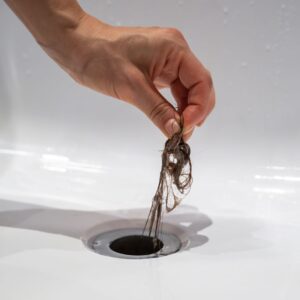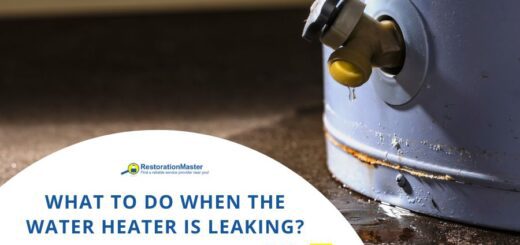Sewage Backup: Identifying Causes and Preventive Measures
Indoor floods and plumbing leaks are difficult disasters to handle because they can result in extensive water damage. If the floodingFlooding is the overflow or accumulation of water in areas t... More in your home contains sewageSewage is wastewater containing biological and chemical cont... More or is caused by a sewer backup, the situation will be much more dangerous. SewageSewage is wastewater containing biological and chemical cont... More backup contains microorganisms, bacteria, and human waste and those that come into contact with sewageSewage is wastewater containing biological and chemical cont... More water are at risk for disease or infectionInfection is the invasion and multiplication of harmful micr... More. The mess caused by a sewageSewage is wastewater containing biological and chemical cont... More backup can only be cleaned up by a professional. Because sewer backups are damaging and hazardous to your health, it is best to know the common signs and causes of a sewageSewage is wastewater containing biological and chemical cont... More backup so you can prevent them from happening.
Health Hazards of Sewer Backups: Understanding the Risks
SewageSewage is wastewater containing biological and chemical cont... More backups can indeed pose significant health risks due to the release of airborne contaminants and physical pollutants. Inhalation of these vapors can leadLead is a heavy metal that can be toxic to humans, especiall... More to a range of symptoms, including cramping, vomiting, fever, gastroenteritis, headaches, weakness, and loss of appetite. Moreover, exposure to specific substances found in sewageSewage is wastewater containing biological and chemical cont... More backups can exacerbate health issues or leadLead is a heavy metal that can be toxic to humans, especiall... More to additional complications.
SewageSewage is wastewater containing biological and chemical cont... More contaminationContamination is the presence of harmful or unwanted substan... More is responsible for around 2 million cases of illness per year according to the National ResourcesResources include tools, personnel, equipment, and materials... More Defense Council.
- Hydrogen Sulfide: SewageSewage is wastewater containing biological and chemical cont... More backups may release hydrogen sulfide, a highly toxic gas with a distinct “rotten egg” odorAn odor is a smell, often detectable by the human nose, whic... More. Inhalation of hydrogen sulfide can irritate the eyes and respiratory tract, leading to symptoms such as eye irritation, coughing, and respiratory distress. Furthermore, exposure to high concentrations of hydrogen sulfide can be fatal due to its ability to inhibit cellular respiration.
- Bacterial ContaminationContamination is the presence of harmful or unwanted substan... More: SewageSewage is wastewater containing biological and chemical cont... More contains a plethora of harmful microorganisms, including bacteria, virusesViruses are microscopic infectious agents that can only repr... More, and protozoa. Contact with these pathogensPathogens are microorganisms such as bacteria, viruses, or f... More can result in various illnesses, ranging from gastrointestinal infections to severe systemic diseases. For instance, bacterial pathogensPathogens are microorganisms such as bacteria, viruses, or f... More like E. coli and Salmonella can cause gastroenteritis, characterized by symptoms such as diarrhea, vomiting, and abdominal cramps. In severe cases, these infections can leadLead is a heavy metal that can be toxic to humans, especiall... More to dehydration and organ failure, posing a significant risk to vulnerable populations.
- Carbon Monoxide: Exposure to carbon monoxide, a colorless, odorless gas produced during the incomplete combustion of organic materialsOrganic materials are derived from living organisms, such as... More, can result in headaches, dizziness, nausea, and in severe cases, unconsciousness or death. This gas competes with oxygenOxygen is a chemical element essential for combustion and li... More for binding sites on hemoglobin, reducing the blood’s capacity to transport oxygenOxygen is a chemical element essential for combustion and li... More, thereby impairing vital organ functions.
- Sewer Gas: Sewer gas, a mixture of various gases such as methane, ammonia, and sulfur dioxide, can have detrimental effects on human health. Inhalation of sewer gas can leadLead is a heavy metal that can be toxic to humans, especiall... More to symptoms such as fatigue, irritated eyes, coughing, nausea, shortness of breath, headaches, irritability, memory issues, and dizziness. Prolonged exposure to these gases can result in chronic respiratory conditions and neurological impairment.
Given the potential health hazards associated with sewageSewage is wastewater containing biological and chemical cont... More backups, it is imperative to approach cleanup and mitigation efforts with caution. Additionally, seeking professional assistance for thorough sewage cleanup and restoration is advisable to mitigateTo mitigate is to reduce or limit the severity of damage, ri... More exposure to hazardous substances effectively.
Sewage Backup Causes and Warning Signs
Now that we’ve seen the array of health issues that can crop up when dealing with sewageSewage is wastewater containing biological and chemical cont... More backups, it’s time we understand what’s causing these messy situations in the first place. Knowing the main reasons behind sewageSewage is wastewater containing biological and chemical cont... More backups helps us take charge and prevent them from happening.
SewageSewage is wastewater containing biological and chemical cont... More backups are typically the result of a clogged sewer line which is nearly impossible to spot. However, there are three warning signs of a clogged sewer line that you should look for in your home:
- Clogs: One of the primary causes of sewer backups is the formation of clogs. These blockages often stem from the accumulation of grease, oil, fats, and non-biodegradable items like paper towels or wipes, which restrict the flow of wastewaterWastewater is used water that contains contaminants, chemica... More within the sewer pipes.
- Heavy Rainfall: Intense storms and heavy rainfall can inundate sewer systems, causing them to become overwhelmed with excess water. This surge in volume can attract tree roots seeking moisture, leading to infiltrationInfiltration is the process by which water, air, or other su... More into sewer pipes and subsequent blockages that contribute to backups.
- Damaged Pipes: Sewer backups frequently occur due to damaged or deteriorating pipes. Pipes may sustain cracks, breaks, or collapses over time due to factors such as aging infrastructure, ground shifting, or pressure from vehicles passing overhead, resulting in disruptions to the flow of wastewaterWastewater is used water that contains contaminants, chemica... More.
- System Overload: During periods of intense precipitation, sewer systems can reach their maximum capacity, unable to accommodate the influx of water. This overload can leadLead is a heavy metal that can be toxic to humans, especiall... More to backups as the system struggles to manage the excessive volume of wastewaterWastewater is used water that contains contaminants, chemica... More.
- Municipal Sewer Issues: Sewer backups may also originate from problems within the municipal sewageSewage is wastewater containing biological and chemical cont... More infrastructure. Malfunctions, blockages, or overflows in the city’s sewer system can cause wastewaterWastewater is used water that contains contaminants, chemica... More to flow backward into residential properties, contaminating sinks, toilets, and drains.
- Aging Infrastructure: As sewer systems age, the risk of failures and breakdowns increases. Aging pipes are susceptible to corrosion, deterioration, and structural weaknesses, making them prone to leaks, cracks, or collapses that can contribute to backups and pose significant challenges for maintenanceMaintenance is the routine care, inspection, and repair of a... More and repairRepair is the act of fixing or restoring damaged property, m... More efforts.
Understanding the different things that can cause sewer backups is key. It helps us figure out what to do to prevent them and keep our sewer systems in good shape. By staying on top of maintenanceMaintenance is the routine care, inspection, and repair of a... More and taking action before problems arise, we can lower the risk of backups and keep everything running smoothly when we need it.
How to Prevent Sewage Backup at Home?
The best action you can take against sewageSewage is wastewater containing biological and chemical cont... More backups is to prevent them in the first place. The following actions can help you avoid sewageSewage is wastewater containing biological and chemical cont... More backups in your home:
-
 Inspect and Clean Sewer Lines: Schedule regular inspections by a professional plumber to check for any signs of blockages, damage, or tree root intrusion in your sewer lines. Periodic cleaningPeriodic cleaning is scheduled cleaning performed at regular... More using methods like hydro-jetting can help remove debris and prevent clogs.
Inspect and Clean Sewer Lines: Schedule regular inspections by a professional plumber to check for any signs of blockages, damage, or tree root intrusion in your sewer lines. Periodic cleaningPeriodic cleaning is scheduled cleaning performed at regular... More using methods like hydro-jetting can help remove debris and prevent clogs. - Proper Disposal Practices: Avoid flushing non-biodegradable items like wipes, paper towels, and feminine hygiene products down the toilet. Dispose of grease, oils, and fats in designated containers instead of pouring them down drains, as they can solidify and cause blockages.
- Tree Root Management: Trees near your sewer lines can send roots into pipes, causing blockages and damage. Consider planting trees away from sewer lines or installing root barriers to prevent root intrusion.
- Check Sewer VentilationVentilation is the process of exchanging or circulating air ... More: Ensure that sewer vents are clear of debris and obstructions to prevent air pressure buildup, which can leadLead is a heavy metal that can be toxic to humans, especiall... More to backups.
- Install Backflow PreventionPrevention refers to actions taken to reduce the likelihood ... More Devices: Backflow preventionPrevention refers to actions taken to reduce the likelihood ... More devices, such as check valves and backwater valves, can prevent sewageSewage is wastewater containing biological and chemical cont... More from flowing back into your home during sewer system surges or floodingFlooding is the overflow or accumulation of water in areas t... More.
- Sump PumpA sump pump is a pump installed in a basement or crawlspace ... More MaintenanceMaintenance is the routine care, inspection, and repair of a... More: If your home has a sump pumpA sump pump is a pump installed in a basement or crawlspace ... More, make sure it’s properly maintained and equipped with a battery backup to prevent basement floodingFlooding is the overflow or accumulation of water in areas t... More during heavy rains or sewer backups.
- Monitor Water Usage: Be mindful of your water usage habits and avoid overloading your sewer system. Spread out water usage activities like laundry and dishwashing throughout the day to prevent sudden surges in wastewaterWastewater is used water that contains contaminants, chemica... More flow.
- Upgrade Aging Infrastructure: Consider upgrading aging sewer pipes and infrastructure to modern, corrosion-resistant materials. This can improve the reliability and longevity of your sewer system and reduce the risk of backups due to pipe deterioration.
Emergency Preparedness When You Find Sewage Backup Flooding
Despite your best efforts, emergencies can still occur. It’s essential to have a plan in place to respond to sewageSewage is wastewater containing biological and chemical cont... More backups quickly and effectively:
- Know the Signs: Familiarize yourself with the warning signs of a potential sewer backup, such as slow drains, gurgling noises, foul odors, or sewageSewage is wastewater containing biological and chemical cont... More backups in basement floor drains.
- Emergency Contact Information: Keep a list of emergency contacts, including your plumber’s contact information and the number for your local sewageSewage is wastewater containing biological and chemical cont... More department, readily available in case of a backup.
- Take Immediate Action: If you suspect a sewageSewage is wastewater containing biological and chemical cont... More backup, turn off the main water supply to your home to prevent further damage, and contact a professional for sewage backup cleaning.
Which areas in the house are more prone to sewage flooding?
Several areas in the house are more prone to sewageSewage is wastewater containing biological and chemical cont... More floodingFlooding is the overflow or accumulation of water in areas t... More due to their proximity to plumbing fixtures and sewer lines. These areas include:
- Basements: Basements are often the lowest point in a house and typically contain plumbing fixtures such as floor drains, toilets, sinks, and laundry facilities. If the sewer line becomes clogged or overloaded, sewageSewage is wastewater containing biological and chemical cont... More backup can occur in the basement, causing extensive damage to the structureStructure refers to the framework or components of a buildin... More and contents.
- Ground-level bathrooms: Bathrooms located on the ground level, especially those with toilets situated below street level, are at higher risk of sewageSewage is wastewater containing biological and chemical cont... More floodingFlooding is the overflow or accumulation of water in areas t... More. If the sewer line becomes blocked or overwhelmed, sewageSewage is wastewater containing biological and chemical cont... More can back up through toilets, sinks, and floor drains, floodingFlooding is the overflow or accumulation of water in areas t... More the bathroom and adjoining rooms.
- Utility rooms: Utility rooms that house water heaters, washing machines, and other plumbing fixtures are susceptible to sewageSewage is wastewater containing biological and chemical cont... More floodingFlooding is the overflow or accumulation of water in areas t... More if the sewer line becomes compromised. A sewageSewage is wastewater containing biological and chemical cont... More backup in the utility room can damage appliances, electrical systems, and stored items, posing safety hazards and requiring costly repairs.
- Crawl spaces: Homes with crawl spaces beneath the main living area may be vulnerable to sewageSewage is wastewater containing biological and chemical cont... More floodingFlooding is the overflow or accumulation of water in areas t... More if the sewer line runs through or near the crawl space. A sewageSewage is wastewater containing biological and chemical cont... More backup in the crawl space can contaminate the area and compromise the structural integrity of the house, necessitating thorough cleaning and remediation efforts.
- Outdoor drains: Drains located near the exterior of the house, such as basement window wells, patio drains, and driveway drains, can become clogged with debris or overwhelmed during heavy rainfall, leading to sewageSewage is wastewater containing biological and chemical cont... More floodingFlooding is the overflow or accumulation of water in areas t... More in the surrounding area.
Contact RestorationMaster for Sewage Cleanup

SewageSewage is wastewater containing biological and chemical cont... More backups present a major problem in your home because of the potential damage and negative health effects but by recognizing the warning signs and taking preventive actions, you can prevent a sewer backup. If you do experience a sewageSewage is wastewater containing biological and chemical cont... More backup or in-home floodingFlooding is the overflow or accumulation of water in areas t... More that may contain sewageSewage is wastewater containing biological and chemical cont... More, call a water damage restoration professional right away. These professionals are highly trained to deal with sewageSewage is wastewater containing biological and chemical cont... More water and ensure that it is removed safely.












